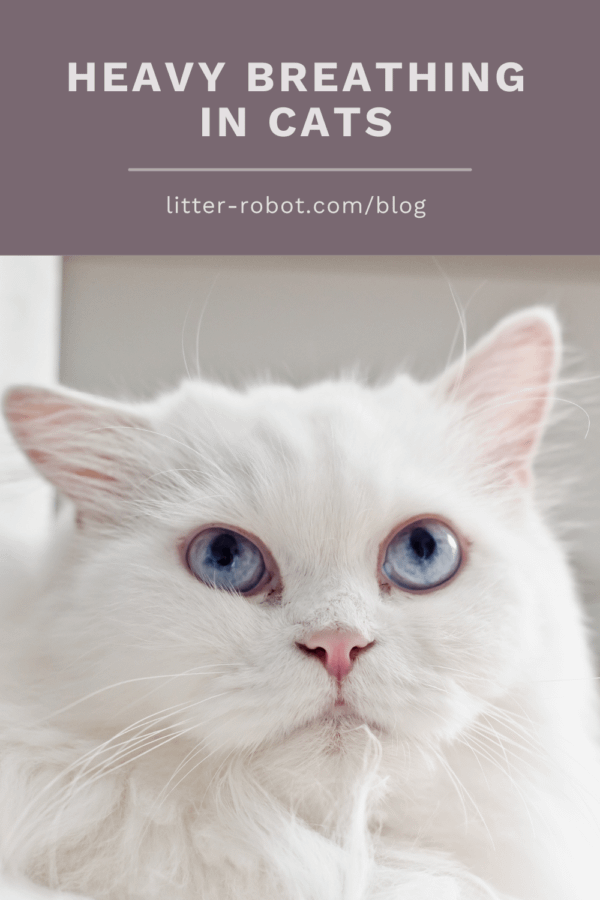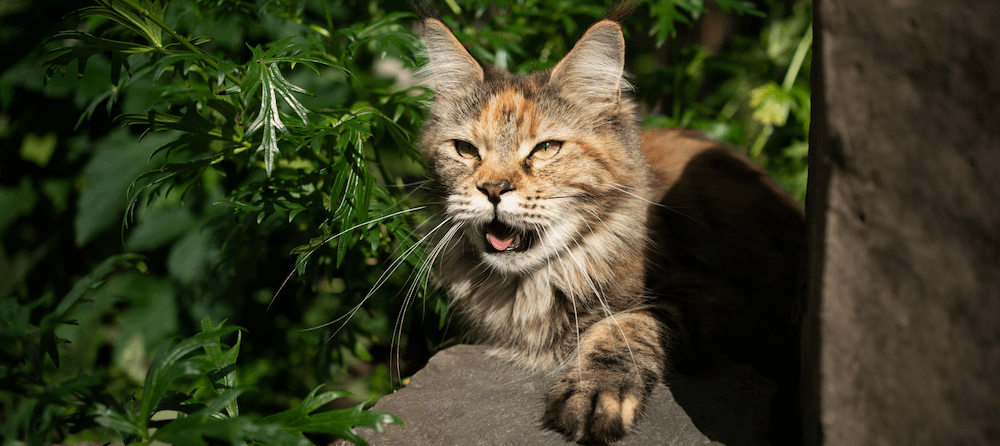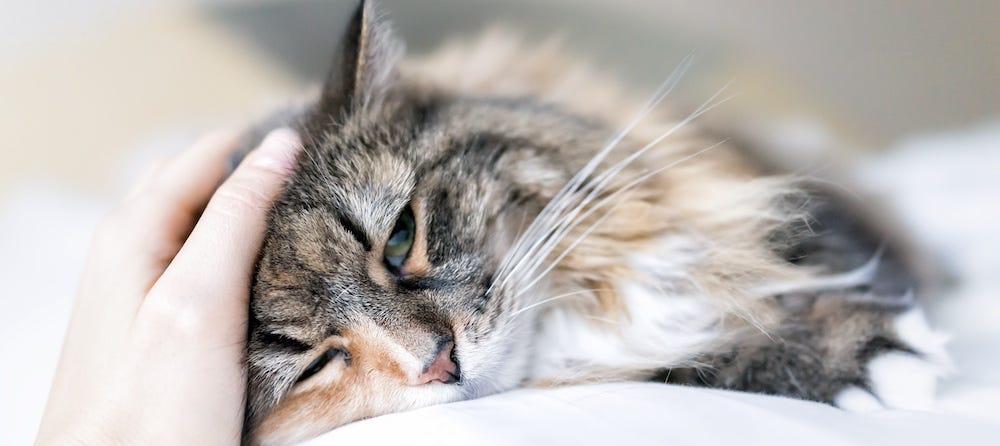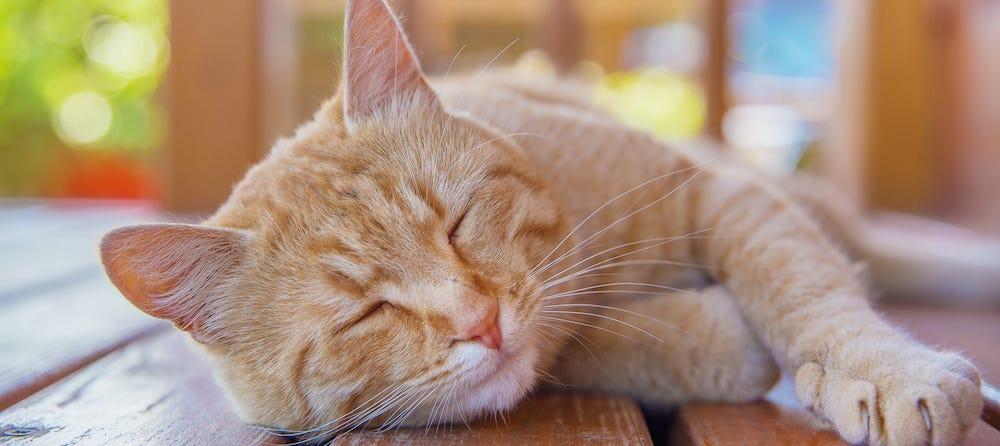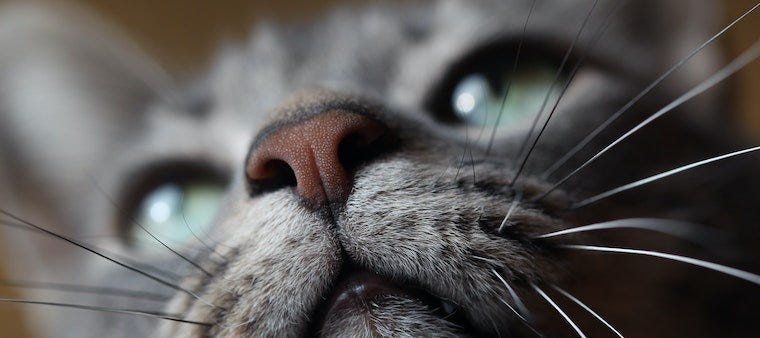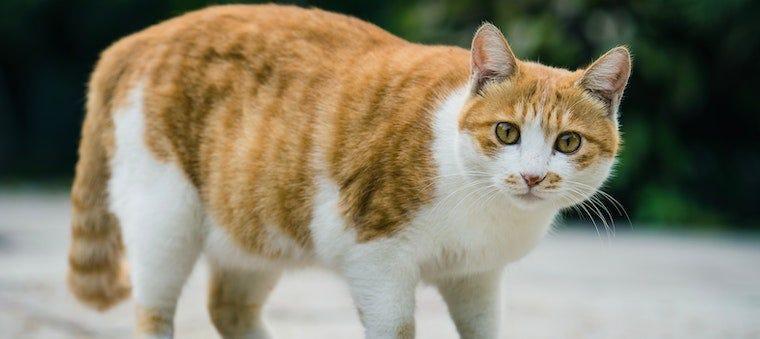Have you noticed your cat’s breathing is louder than usual? If so, you might feel a growing concern over their respiration patterns. While not all heavy breathing in cats is cause for alarm, you should pay close attention to your fur baby’s breathing to determine if you need to visit the vet. While dogs pant often, here are a few things you should consider regarding cats.
What is normal breathing for cats?
To better understand what heavy breathing in cats looks like, you might need to consider what normal breathing looks like. A cat's resting respiration rate typically ranges from 15 to 30 breaths per minute. A good rule of thumb? Contact your vet if your cat’s respiratory rate is consistently over 50 breaths per minute at rest, but they appear otherwise fine. If your cat’s respiratory rate is consistently elevated and they have other symptoms such as increased respiratory effort, coughing, weakness, or a swollen abdomen, go to the emergency vet immediately.
How to calculate a cat’s respiratory rate
The easiest way to calculate the respiratory rate of a cat is to count the number of breaths in 15 seconds and multiply by 4 to get the total breaths per minute. You can use your phone or a timer to keep track.
If your cat isn’t cooperating, try holding a cup or handheld mirror in front of their face under their nose and count the respiratory rate based on the resulting fog. Another method you can use is to place your hands lightly on the sides of your cat’s stomach and count your cat’s stomach movements as they breathe in and out: this is a little more difficult to feel, but can be attempted.
Reasons why your cat is breathing so hard
You tracked your cat's breathing and noticed they were breathing hard—now what? First, it is important to stay calm if you sense your animal is in distress. There are a few reasons your cat may be breathing heavily, and some are more serious than others. Let’s take a look.
Cat dyspnea
Trouble breathing, or cat dyspnea, is not uncommon and should be taken seriously. This can be caused by a variety of conditions. Though it can be concerning and scary to watch your kitty struggling to breathe, it can be treated once the underlying cause is determined.
In addition to heavy breathing, a cat with dyspnea might cough, foam at the mouth, experience open-mouth breathing, or have blue-tinged gums. If any of these symptoms occur, take your cat to the emergency vet to get assessed immediately.
Pregnant or laboring
Though panting is not as common for cats as it is for dogs, there are times when heavy breathing in cats is normal—like when they are pregnant, especially laboring. If your pregnant cat is panting and acting strange, some kittens might be on the way!
Heat and exercise
Finding your feline friend panting after exercise is normal and does not need to be monitored closely—unless the heavy breathing lasts a significant amount of time after playtime. Provide cats with fresh water and food after exercise play, especially if you notice them panting more on a hot summer day. (Be sure to monitor for signs of heat exhaustion.) If you notice your cat panting after a day of little to no movement, this could be reason enough to contact your vet.
Feline heart disease
Heart disease is a serious medical condition. Fortunately, it is not extremely common in cats. In addition to heavy breathing, other symptoms of feline heart disease include poor appetite, weight loss, sudden collapse, and even sudden paralysis of the hind legs. Feline heart disease can be predisposed in certain breeds of cats. It can be congenital, present at birth, or adult-onset. Either way, this condition can be managed, and depending on the severity, your feline friend can still go on to live a normal life.
Tracheitis
Tracheitis, an infection of the trachea, might appear as rapid and shallow breathing in your cat. It can be accompanied by a cough, and sometimes there can be a bluish tint of the gums and mucous membranes. This is called cyanosis and it is a side effect of too little oxygen in the blood. You should take your cat to the vet right away if you notice these symptoms, or if they are lethargic or not eating.
Cat hay fever
Did you know your cat can get hay fever, too? Though it presents a little differently than in humans, cats can get hay fever, or seasonal allergies, just like us. Some common symptoms of hay fever in cats can include itchy eyes, chewing at their paws, sores or missing patches of fur, and even snoring due to a sore throat. The inflammation resulting from the allergen can cause heavy breathing in your cat.
Generally, cat hay fever is not too much of a concern, but you’ll want to find the source of the allergy to help your cat. This could include bathing or wiping off their paws to remove pollen from their fur if they’ve been outside. If allergies are a regular problem for your cat, scheduling an appointment with your vet to determine if they could benefit from an allergy medication is best.
Asthma
Asthma is an all-too-common diagnosis in cats. Feline asthma is caused by an allergic reaction to inhaled allergens. This can be dust, candles, incense, or even cologne. Inhaling these allergens can trigger an immune response that causes inflammation. The inflammation can make it difficult for your cat to breathe.
Feline asthma can include coughing, hacking, and vomiting. Though asthma can be managed, it is important to monitor heavy breathing and the symptoms mentioned. If you find this issue is happening often, bring it up to your vet at an appointment and have your cat tested.
Foreign objects
If your cat suddenly has trouble breathing, check their mouth and airway for choking hazards. Be sure that small toys or any choking hazard are out of the way to keep your cat safe.
Note: You might not be able to see a piece of a toy or choking hazard lodged in your cat’s throat. If you believe your cat is choking, get them to an animal hospital immediately.
Anxiety or nervousness
If a cat is anxious or nervous, you might notice a change in their breathing pattern. Cats can pant in times of emotional distress. You can calm your cat down by comforting them and even giving them free space to roam, utilizing cat pheromones, or cat calming treats, just to name a few options. If you find that your cat is often plagued with anxiety and it is causing panting and other symptoms, consider consulting a vet to help them manage their symptoms.
Respiratory infection
Have a sneezing cat? It could be a sign of a respiratory infection. A respiratory infection is similar to the common cold. They can be viral, bacterial, or fungal and can last for some time. It’s important to remember that a cat respiratory infection is contagious and can be passed along to your other cats. In addition to sneezing and wheezing, you might see heavy breathing in cats, vomiting, gas, diarrhea, and even skin itchiness.
Pneumonia
Pneumonia can occur as a result of a respiratory infection. Though not common, young cats, old cats, and cats with a compromised immune system can be more prone to pneumonia. Cats can have difficulty breathing, fever, dehydration, loss of appetite, weight loss, and difficulty swallowing.
Pneumonia comes in different forms: it can be bacterial or fungal in origin, or it can result from inhaling problematic fumes or substances into the lungs and exposure to smoke or chemicals. It’s vital to get your cat checked out as soon as possible if they exhibit respiratory issues that make you suspect pneumonia.
Hydrothorax
Hydrothorax, or fluid accumulation in and around the lungs, can cause difficulty breathing in your cat. In addition to difficulty breathing, your cat could experience open-mouth breathing, coughing, and lack of energy. You might even see them putting themselves into unusual positions to breathe better.
Heartworm
Heartworm can cause hydrothorax. Another symptom of heartworm is breathing difficulties. Symptoms of heartworm can look a lot different in cats than in dogs. You may notice coughing, vomiting, and even a loss of appetite. Because heartworms are large in size in comparison to cat hearts and associated vessels, one heartworm can potentially be fatal without much warning or time to try to intervene. This is why it is important to keep your cat on regular heartworm prevention.
What should you do if you notice heavy breathing in cats?
You might notice your cat panting after playing or in very warm conditions, but this should not last long. If you notice prolonged panting or your cat panting outside of these conditions, you should contact your veterinarian.
If you suspect that your cat is panting as a result of anxiety, provide some fun items to help them manage those feelings. Your cat might enjoy a private place to lounge or a rechargeable cat laser pointer to burn some energy and readjust.
When in doubt, call your vet!
Heavy breathing in cats isn’t always a reason to panic. But if you count a respiratory rate of over 50 breaths per minute or notice other unusual symptoms, contact your veterinarian.
FAQs
How can I help my cat with breathing problems?
Take your cat to the vet if you notice breathing problems; treatment will depend on the underlying cause. Try to keep the air filtered and clean for your cat at home.
When should I be concerned about my cat’s breathing?
You should be concerned if your cat is having trouble breathing often or has a consistent respiratory rate of over 50 breaths per minute, along with other symptoms such as foaming at the mouth or blue-tinged gums.
What if my cat is breathing loud but not fast?
Noisy or loud breathing could indicate congestion secondary to infection, inflammation in the throat, or a more difficult-to-address foreign body in the throat. Either way, if the volume of your cat’s breathing is outside the norm and you are concerned, call your veterinarian to schedule a consultation.
Why is my pregnant cat breathing fast?
Panting in pregnant cats could be a sign that labor is starting. As long as the panting resolves on its own or at the culmination of kitten delivery, monitoring is likely okay.
Sources:
- Treating 3 Types of Pneumonia in Cats
- Dyspnea (Difficulty Breathing)
- Acute Respiratory Distress Syndrome (Shock Lung) in Cats
- A Practical Approach to Cats with Respiratory Distress
- Feline Respiratory Emergencies
- Home Breathing Rate Evaluation
